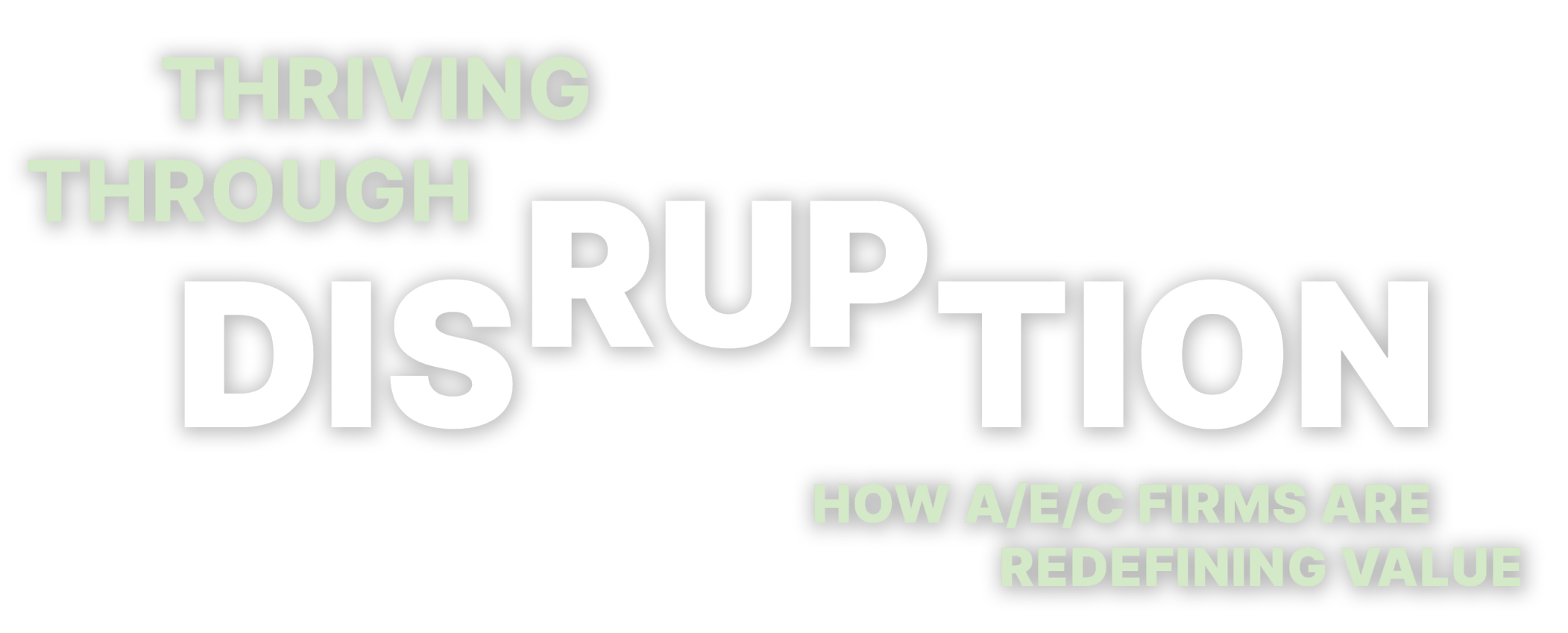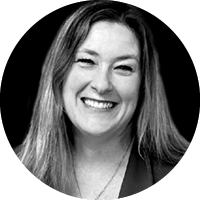



About

COLUMN
10.
CASE STUDY
Value You Can Feel: How The Primestone Group’s Core Values Shape the Client Experience

11.
CASE STUDY
When Values Impart Value: How Culture Creates a Competitive Edge at Lowe Engineers

Using SMPS Foundation Insights to Navigate Change and Strengthen Strategy
The A/E/C industry has always been shaped by economic cycles, policy changes, and technological advancements. But today, the pace of disruption is accelerating, creating a new level of uncertainty for marketers and business developers who must now play a more strategic role in shaping their firms’ resilience and long-term success.
A shifting political landscape is leading to potential changes in infrastructure spending, new tariffs impacting material costs, and workforce shortages reshaping hiring and leadership transitions. At the same time, AI and automation are altering business development (BD) strategies, while client expectations for value-driven partnerships are increasing.
In this rapidly evolving environment, firms that effectively define and communicate their value will thrive. The SMPS Foundation's latest research—"Building Resilience: A/E/C's Path Beyond 2025" and "AEC.BD: Building Business Development Success in a Post-Pandemic World"—offers actionable insights for firms looking to navigate uncertainty, strengthen client relationships, and create a competitive edge.
But value isn’t one-size-fits-all. What works for a 40-person regional firm may look very different from what works for a 1,000-person multidisciplinary international firm. So how can firms identify, leverage, and amplify their value—regardless of their size or position in the market?
Winning Work in an Unpredictable Economy
As market forces shift under new political leadership and global trade pressures, A/E/C firms are being pushed to reassess how they compete for work and sustain their pipelines. The AEC.BD report shows that 74% of firms plan to use the Seller-Doer model, while 56% have added dedicated BD staff—clear indicators that firms are evolving their strategies to meet today’s demands. How those changes take shape, however, varies widely depending on firm size, market focus, and resources.
Large Firms
Large firms with established BD teams may find success from expanding into new market sectors or geographic regions, leveraging their brand strength to diversify revenue streams and hedge against sector slowdowns. These firms often have the infrastructure to pursue large-scale projects even in uncertain conditions.
Mid-Sized Firms
For mid-sized firms, the challenge is different. Many are well-known in their niche but need to balance growth with stability. Strengthening client relationships, leveraging specialized expertise, and targeting high-value projects where they can outshine larger competitors will be key.
Smaller firms
Smaller firms must focus on agility, reputation, and relationships. Competing on price alone isn’t sustainable, so strategies like forming partnerships with larger firms, positioning themselves as subcontractors on major projects or securing local contracts where their responsiveness and personal client connections are advantages can be highly effective.
Regardless of firm size, those that focus on early client engagement, consultative problem-solving, and value-based differentiation will be best equipped to navigate economic uncertainty.
Building a Workforce That Drives Long-Term Value
Beyond economic factors, labor shortages and generational workforce transitions remain pressing concerns. Stricter immigration policies could tighten the skilled labor market, while the retirement of Baby Boomers accelerates leadership transitions in A/E/C firms.
The Building Resilience report highlights that nearly 40% of senior leaders in the A/E/C industry are expected to retire within the next five years, creating a potential void in business development knowledge, client relationships, and firm leadership. Without a structured plan to transfer knowledge and develop emerging leaders, firms risk losing both institutional expertise and competitive advantage.
Meanwhile, Millennials and Gen Z professionals—who now form much of the workforce—are driving new expectations for workplace culture, flexibility, and career growth opportunities. These younger professionals are less willing to wait decades for leadership roles, and firms that lack clear career development pathways risk losing top talent to competitors offering faster advancement and greater opportunity.
According to Building Resilience, firms that actively invest in structured mentorship, career progression planning, and leadership development programs are better positioned to retain top talent, deepen their talent’s knowledge base, and ensure continuity in business development strategy. In fact, a recent Gallup report pointed out that organizations that make a strategic investment in employee development experience 11% higher profitability and are twice as likely to retain their employees. The research behind Building Resilience emphasizes that BD exposure should start earlier in career paths, rather than being reserved for senior staff.
To compete for talent and ensure long-term leadership continuity, firms must:
Provide a clear vision for career growth
Establishing structured BD and leadership pathways helps younger employees see a future at the firm, improving retention and engagement.
Turn mentorship into a competitive advantage
Pairing senior leaders with emerging professionals transfers knowledge, strengthens internal relationships, and extends client relationships to deepen relationships
for continuity.
Meet evolving workplace expectations
While remote work isn't always possible in A/E/C, firms offering hybrid models for marketing and BD teams have seen greater retention and breadth in resources.
Enhance employer branding
A strong public image that highlights career development, sustainability efforts, and diversity initiatives can be a major talent attraction tool.
A firm’s ability to develop and retain talent is directly tied to its ability to sustain long-term client relationships and business success. Those that intentionally invest in workforce development today will build lasting value—both internally and externally.
Technology as a Business Multiplier, Not Just a Trend
The increasing integration of artificial intelligence (AI), automation, and data-driven marketing is reshaping how A/E/C firms engage with clients, track opportunities, and develop proposals. However, as the Building Resilience report warns, technology must be adopted strategically, not simply for the sake of innovation. Without a clear plan, firms risk implementing tools that create more complexity rather than efficiency.
The AEC.BD report highlights that firms leveraging AI-driven insights and CRM analytics are seeing improved pursuit success rates and stronger client engagement. Business developers who use data-backed decision-making can anticipate client needs earlier, target the right pursuits, and create more tailored proposals that differentiate their firms from competitors.
Large Firms
For large firms, AI is already transforming BD and marketing efforts. Advanced CRM analytics, AI-driven proposal automation, and virtual reality client presentations are enabling BD teams to streamline operations, optimize resource allocation, and improve win rates. These firms benefit from big data-driven decision-making, which allows them to refine their strategies based on historical pursuit trends and client behaviors.
Mid-Sized Firms
For mid-sized firms, however, tech adoption must be more selective. The most successful firms in this category focus on automation tools that enhance efficiency without requiring complete overhauls. Examples include AI-generated content for proposals, CRM enhancements that improve pursuit tracking, and automated client follow-ups that ensure BD teams remain engaged with key decision-makers.
Smaller firms
Smaller firms may lack the resources for large-scale AI adoption, but they can still integrate digital tools strategically. Free or low-cost AI-driven solutions—such as AI-powered chatbots for client inquiries, analytics-driven email marketing, and cloud-based collaboration tools—can make an outsized impact without excessive investment.
The Building Resilience report reinforces that the firms seeing the greatest return on technology investments are those that use AI and automation to enhance—not replace—human expertise. A/E/C is an industry built on relationships, and while AI can improve efficiency, firms that fail to maintain the personal, trust-based nature of BD risk losing their competitive advantage.
Rather than chasing every emerging technology, firms that take a measured, intentional approach to AI and automation—aligning digital tools with their unique business development goals—will be best positioned for long-term success.
Curiosity and Quality Questions
In an industry facing rapid change, economic volatility, and shifting workforce dynamics, the most valuable asset firms have is intelligence.
The SMPS Foundation’s research reports are not just industry overviews—they are strategic tools that empower A/E/C marketers and BD professionals to anticipate challenges, adapt strategies, and position their firms for success.
With the need for firms to be more agile, forward-thinking, and innovative, leveraging data-backed insights from industry leaders is critical. Whether navigating economic shifts, labor shortages, or digital transformation, professionals who stay informed will make stronger business decisions, strengthen client relationships, and drive firm growth—even in uncertain times.
As industry challenges continue to evolve, the insights from SMPS Foundation research will continue to provide a roadmap for A/E/C professionals to refine their strategies, anticipate shifts, and drive long-term success.
About the SMPS Foundation
The SMPS Foundation is a nonprofit 501(c)(3) organization established by the Society for Marketing Professional Services to advocate for, educate, and elevate marketing and business development professionals in the A/E/C industry through research and thought leadership. Its mission is to discover, in a scholarly and scientific manner, the trends, challenges, and opportunities facing the A/E/C industry, and to develop and disseminate knowledge that advances the profession of marketing professional services.
The research referenced in this article can be accessed at smps.org/Foundation:
AEC.BD: Building Business Development Success in a Post-Pandemic World
Developed in collaboration with Stambaugh Ness
Building Resilience: A/E/C’s Path Beyond 2025
Developed in collaboration with Carla Johnson, RE: Think Lab
Whether it’s adding a little extra to your annual membership or making a planned multi-year gift, we invite you to help us create a lasting impact and continue delivering A/E/C Intelligence™. Support your Foundation today.
Fawn Radmanich FSMPS, CPSM, is a Strategic Pursuit Leader for Stantec’s Water Strategic Pursuits Team with 25 years in the A/E/C industry. A Fellow of the Society for Marketing Professional Services and an SMPS Foundation Board Trustee, Fawn is a published author and speaker known for her forward-looking approach to leveraging innovation and strategy to drive success in an evolving marketplace.
Connect on Linkedin










